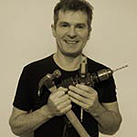 |
 |
Home
Tools
Drilling and Fixing
Putting Things Up
Repairs/Maintenance
Plumbing
Electrics
Woodwork
Decorating a Room
Tiling
Safety & Security
Saving Energy
House and Finance
Health&Safety
Disclaimer
Contact
Advertising
Useful Links
Site Map
Voltage, Current, Amps, Power, Watts |
|||||
| These terms can be a little confusing but in fact are fairly straightforward | |||||
Voltage can be regarded as a pressure which pushes the electricity around the circuit. It's measured in VOLTS . In the UK electricity is supplied into our homes at 230Volts and this stays fairly constant. All your appliances, light bulbs, etc. are designed to run at 230 volts. Some appliances run at lower voltages but they will have a transformer which "transforms" the voltage down to whatever is required. eg 12 volts for low voltage down lighters. They are all still receiving 230 volts from your electricity supply. Current is the rate of flow of electricity round the circuit. It is measured in AMPS. Something like a fan heater will require much more current to flow than something like a light bulb. Each of the circuits running from your consumer unit(fuse box) will have a protection fuse or a circuit breaker which is rated in amps. The size will vary depending on what the circuit is for eg a lighting circuit will be much less than a cooker circuit. Power is the amount of electrical energy used to make something work and is a combination of voltage and current (measured in volts and amps) Power is measured in WATTS In fact Power = Voltage x Current Or, Watts= Volts x Amps So if you buy a light bulb it could be rated at 230 volts and 60 watts The bigger the wattage the brighter will be the bulb and the more power it will use and your electricity bill will be higher. |
|||||